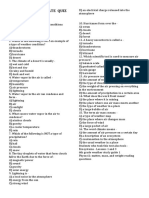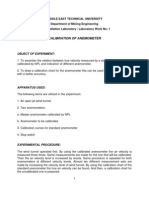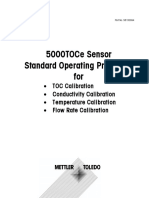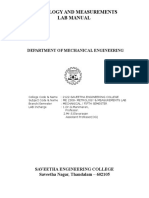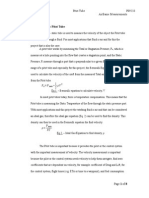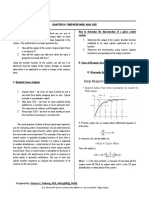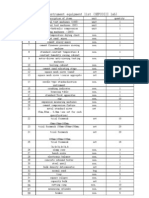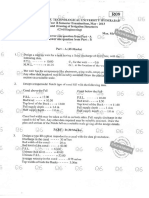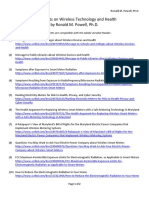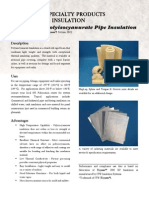Pneumatic Comparator
Pneumatic Comparator
Uploaded by
nvemanCopyright:
Available Formats
Pneumatic Comparator
Pneumatic Comparator
Uploaded by
nvemanCopyright
Available Formats
Share this document
Did you find this document useful?
Is this content inappropriate?
Copyright:
Available Formats
Pneumatic Comparator
Pneumatic Comparator
Uploaded by
nvemanCopyright:
Available Formats
PRODUCT MEASUREMENT AND CONTROL
LESSON 17: CONSTRUCTION AND WORKING OF PNEUMATIC COMPARATOR
Objective:
Our objective in this lesson is to learn construction and working of pneumatic Comparators. Figure 2 shows the working principle of a pneumatic comparator. A pressure reducer and regulator reduces the high-pressure air supply to a value of about 0.007 N/mm2 and this pressure is maintained closely by including a restriction between the regulator and dip tube A. Initially, the levels of liquid in the tank B and the dip tube are the same. When the air under pressure is supplied to the system, the liquid in the dip tube will be pushed out into the tank. Any pressure greater than needed to just clear-the dip tube will escape through it into the tank as air bubbles. Thus, the pressure between the regulator and the control orifice O1 will always, be exactly the same, irrespective of any variation in air pressure. Air after passing through the control orifice O1 will reach the mouth of measuring orifice O2. Back pressure will build up behind the measuring orifice if it is not able to pass the coming air flow. Due to this back pressure the level of the liquid in the manometer tube will change. Back pressure is created due to the restriction at the mouth of the orifice O2 caused by the variations in the dimensions of the work being checked. Thus, the manometer tube can be calibrated to give the measurement deviation from a standard.
Motivation: By learning this lesson, you will know about last but not the least type of comparator which is pneumatic comparator
Introduction:
In last lesson, we have seen the electrical and optical comparators. Let me now continue with the pneumatic comparator and describe for your benefit, its aspects .
Pneumatic Comparator. In pneumatic comparators, either air flow or air pressure is measured to give measurement deviations from a standard. The response of the comparators working on air flow is quicker than those working on air pressure, but the later are more versatile than the former, The pneumatic gauging is based on Bernoullis theory. The basic principle of a pneumatic comparator is explained in Figure 1. If air at a low but constant pressure, Ps is allowed to flow through a small jet or orifice O1 into an intermediate chamber and then through a second orifice O2 to atmosphere, then the intermediate pressure pi in the intermediate chamber will depend on the relative sizes of the two orifices, Since the flow of air through the two orifices is the same, the pressure drop across them will depend on the resistances they offer to the flow, that is, on their sizes. If the size of the orifice O1 is kept constant, then the change in Pi will depend upon the variation in the size of the orifice O2. The change in the intermediate pressure, Pi can be calibrated in terms of the change in the size of the orifice O2 which can be the measurement deviation from a standard.
Figure 1 Basic principle of pneumatic comparator The first application of such a gauge was in the checking of the bores of motorcar cylinder blocks and it is now almost the universal method of doing this in production. The magnification that can be provided depends on the relative size of the orifices O1 and O2 and may be as high as 20,000:1, but are usually about 1000-5000:1.
7.233
Figure 2 Working principle of pneumatic comparator Another design of pneumatic comparator is shown in Figure 3. Air pressure from about 0.42 to 0.875 N/mm2 is reduced to about 0.07 to 0.14 N/mm2 as it enters a calibration valve. This air is set with the help of a standard test piece and all other workpieces are checked against this standard. Any difference in size from that of the standard test piece will result in a difference in air pressure. These air differences will be indicated by a float in a calibrated glass tube, which is sealed in the lowpressure side of the comparator. If a given workpiece is undersize, the float position will be below the standard position and a high float position indicates oversized work
Copy Right: Rai University
43
piece. For gauging external surfaces, the reverse will be true. This comparator can be used to check true dimensions of out of round bell mouthing, parallelism, flatness, camber and concentricity.
4) Engineering Metrology by R. K. Jain
PRODUCT MEASUREMENT AND CONTROL
Notes
Figure 3 Pneumatic comparator Important features of a typical comparator are shown in Figure 4. Measuring head moves up and down the vertical column. For moving the head vertically, the clamp for the head is loosened. There are two devices for coarse adjustment and fine adjustment of the measuring head. Coarse adjustment causes the measuring head to move vertically along the column. Fine adjustment is used for bringing the pointer to zero. When the required movement of the measuring head is achieved, it is champed with the help of head clamp.
Figure 4 A typical comparator This brings us to the end of this lesson wherein you have learnt what is pneumatic comparator . I hope that you have aware of this topic to a great extent. Let us now move onto some helpful exercise.
Exercise:
1) Explain the principle of pneumatic comparator. 2) Explain the features of pneumatic comparator with the help of neat sketch.
Reference:
Apart from this course pack, I would like you to refer following books for your betterment. 1) A text book of Production Engg. By P. C. Sharma 2) Production Technology by R. K. Jain 3) Production Technology by O.P. Khanna
44 Copy Right: Rai University 7.233
You might also like
- Weather and Climate QuizDocument4 pagesWeather and Climate QuizGina Dio Nonan100% (1)
- LabDocument6 pagesLabamyNo ratings yet
- Assessment Test - Hope 1Document5 pagesAssessment Test - Hope 1Queenie Gamboa100% (4)
- Certificate of Calibration: Name G.C. Thompson SignatureDocument3 pagesCertificate of Calibration: Name G.C. Thompson Signatureebbasingh100% (1)
- Aerodynamics Experiment A2 M (1) .O.hyjaniDocument4 pagesAerodynamics Experiment A2 M (1) .O.hyjaniJuan NightstandNo ratings yet
- MMM Lab ManualDocument13 pagesMMM Lab ManualSangam PatilNo ratings yet
- 070 - ME8501 Metrology and Measurements - Anna University 2017 Regulation Syllabus PDFDocument2 pages070 - ME8501 Metrology and Measurements - Anna University 2017 Regulation Syllabus PDFSidhu Vev Sidhu0% (1)
- Calibration PresentationDocument25 pagesCalibration Presentationchirag patelNo ratings yet
- Measurements and Dimensional AnalysisDocument29 pagesMeasurements and Dimensional AnalysisXainNo ratings yet
- Hydraulic Pump ManualDocument7 pagesHydraulic Pump ManualLaterNo ratings yet
- Electrical Measuring & Test InstrumentsDocument42 pagesElectrical Measuring & Test InstrumentsMichael Parohinog GregasNo ratings yet
- Exp No. 02 Study and Use of ComparatorsDocument8 pagesExp No. 02 Study and Use of Comparatorsrohit thorawadeNo ratings yet
- Calibration RigDocument5 pagesCalibration RigBijoy AyyagariNo ratings yet
- Calibration of AnemometerDocument4 pagesCalibration of AnemometerAhmet ŞenNo ratings yet
- Cad/Cam 2 Mid Online BitsDocument6 pagesCad/Cam 2 Mid Online Bitstslnarayana33% (3)
- ALM 35 Manual MESDocument73 pagesALM 35 Manual MESgokuleee004No ratings yet
- Lab Equipment List FinalDocument10 pagesLab Equipment List FinalYasir Ali DharejoNo ratings yet
- 2 Marks MMDocument5 pages2 Marks MMPappujiNo ratings yet
- Ba Tho 5000toce Full Calibration Sop en 58130094bDocument38 pagesBa Tho 5000toce Full Calibration Sop en 58130094bعبدالعزيز بدرNo ratings yet
- List of Instruments in Civil Engineering LaboratoriesDocument1 pageList of Instruments in Civil Engineering LaboratoriesfrogNo ratings yet
- Sop-34 Calibration With Dead Weight TesterDocument3 pagesSop-34 Calibration With Dead Weight TesterOSAMANo ratings yet
- A Mini-Project Report Course Code: 17AE4DCAP-I: "Model of Air-Compressor Using A Syringe"Document9 pagesA Mini-Project Report Course Code: 17AE4DCAP-I: "Model of Air-Compressor Using A Syringe"Shreya Giri0% (1)
- Oiml TC17 SC2 N3 2007Document25 pagesOiml TC17 SC2 N3 2007acanis1016No ratings yet
- MQA Lab ReportDocument15 pagesMQA Lab ReportMuhammad Waleed TariqNo ratings yet
- Samsung Swf-p12 Service ManualDocument2 pagesSamsung Swf-p12 Service ManualAivar JanessooNo ratings yet
- Metrology Lab ManualDocument21 pagesMetrology Lab ManualelavarasanNo ratings yet
- Measuring MachineDocument19 pagesMeasuring Machinegopir28No ratings yet
- Rotameter CalibrationDocument5 pagesRotameter Calibrationengineer63100% (1)
- NIST Handbook PDFDocument426 pagesNIST Handbook PDFFaryalBalochNo ratings yet
- Calibration: A Technician'S GuideDocument4 pagesCalibration: A Technician'S GuideNia dewiNo ratings yet
- HEPA Filtration System Performance of Residential and Commercial Vacuum CleanersDocument3 pagesHEPA Filtration System Performance of Residential and Commercial Vacuum CleanersMartin TapankovNo ratings yet
- Pitot Tube Report REV - 01Document8 pagesPitot Tube Report REV - 01JavierLugoNo ratings yet
- ME8501 Metrology and Measurements PDFDocument93 pagesME8501 Metrology and Measurements PDFpuneetNo ratings yet
- Toxic DetectorDocument69 pagesToxic DetectorOmnhick100% (1)
- Dissolved Oxygen Probe Calibration ProcedureDocument3 pagesDissolved Oxygen Probe Calibration ProcedureRajuNo ratings yet
- Me2304 - Engineering Metrology and Measurements Question Bank For Regulation 2008Document29 pagesMe2304 - Engineering Metrology and Measurements Question Bank For Regulation 2008Ashok Kumar Rajendran75% (4)
- Micrometer CalibrationDocument2 pagesMicrometer Calibrationpammy313No ratings yet
- NIST Charpy Verification ProgramDocument41 pagesNIST Charpy Verification ProgramJerry Man UtdNo ratings yet
- Mechathon Problem Statement-2 PDFDocument3 pagesMechathon Problem Statement-2 PDFFarhan Ahamed HameedNo ratings yet
- Sensors and Transducers: Introduction To MechatronicsDocument32 pagesSensors and Transducers: Introduction To Mechatronicsmann20100% (1)
- Non Conventional IC EngineDocument8 pagesNon Conventional IC EngineKiran KumarNo ratings yet
- R17 Mechatronics Syllabus PDFDocument112 pagesR17 Mechatronics Syllabus PDFScientist SakthivelNo ratings yet
- EN Calibration GeometryDocument3 pagesEN Calibration GeometryHARIOM INSTRU-LABS100% (1)
- F71-F90 Dial IndicatorApplication PDFDocument20 pagesF71-F90 Dial IndicatorApplication PDFKiranNo ratings yet
- Unit 2 MetrologyDocument32 pagesUnit 2 MetrologyMuthuvel M83% (6)
- EURAMET-cg-08 V 2.1 ChangesDocument18 pagesEURAMET-cg-08 V 2.1 ChangesGilberto Andrés JuradoNo ratings yet
- Nabl 122 01 PDFDocument36 pagesNabl 122 01 PDFmahesh100% (1)
- AUTOCOLLIMATORDocument6 pagesAUTOCOLLIMATORAhmed Almujabber100% (1)
- DKD R 6 2 t5 e PDFDocument9 pagesDKD R 6 2 t5 e PDFDragan Ilic100% (1)
- Mettler Pj1220 ManualDocument3 pagesMettler Pj1220 ManualMehrdad AkbarifardNo ratings yet
- Module 5Document4 pagesModule 5SohnNo ratings yet
- IC ENGINES NOTES Unit 2Document41 pagesIC ENGINES NOTES Unit 2Satya NarayanaNo ratings yet
- Calibration For The Lux MeterDocument1 pageCalibration For The Lux MeterBonifacio SautNo ratings yet
- Test Instrument Equipment List (Sepcoiii Lab)Document2 pagesTest Instrument Equipment List (Sepcoiii Lab)Kuldeep ChakerwartiNo ratings yet
- Infrared Pyrometer HandbookDocument19 pagesInfrared Pyrometer Handbookjoyous leeNo ratings yet
- 01 BernoulliDocument4 pages01 Bernoullithing909No ratings yet
- 2.2 Flow Measurement: Bernoulli's EquationDocument5 pages2.2 Flow Measurement: Bernoulli's EquationTAREK ALMAHDYNo ratings yet
- FME Notes Unit5Document16 pagesFME Notes Unit5vishal shuklaNo ratings yet
- Pressure and TempratureDocument58 pagesPressure and Tempraturefakefcc0909No ratings yet
- Aerodynamics Lab ManualDocument50 pagesAerodynamics Lab Manualshibin874141No ratings yet
- 7567 PDFDocument13 pages7567 PDFZezo HassanNo ratings yet
- Design and Drawing of Irrigation StructuresDocument2 pagesDesign and Drawing of Irrigation StructuresnvemanNo ratings yet
- Machine DrawingDocument2 pagesMachine DrawingnvemanNo ratings yet
- Part-A: FA B.E. Iv/Iv (MJP) I Se AutomDocument1 pagePart-A: FA B.E. Iv/Iv (MJP) I Se AutomnvemanNo ratings yet
- Management Information SystemsDocument2 pagesManagement Information SystemsnvemanNo ratings yet
- 157 - Metallurgy and Material Science (Sem - I) (Supply)Document2 pages157 - Metallurgy and Material Science (Sem - I) (Supply)nvemanNo ratings yet
- Documents On Wireless Technology and Health by Ronald M. Powell, Ph.D.Document2 pagesDocuments On Wireless Technology and Health by Ronald M. Powell, Ph.D.Ronald M. Powell, Ph.D.100% (1)
- Capital Gain Compensation Recd From Central GovernmentDocument45 pagesCapital Gain Compensation Recd From Central Governmentphani raja kumarNo ratings yet
- Rc28-12 30 SeriesDocument24 pagesRc28-12 30 SeriesYuhNo ratings yet
- Installation Instructions: Parts in Kit Qty. DescriptionDocument11 pagesInstallation Instructions: Parts in Kit Qty. Descriptionjaime bolivarNo ratings yet
- ProstuDocument3 pagesProstujalijaNo ratings yet
- Catherine-Xp: Compact High Performance Thermal ImagerDocument2 pagesCatherine-Xp: Compact High Performance Thermal ImagerBeca LopeNo ratings yet
- Wonderful Past Simple and Present PerfectDocument4 pagesWonderful Past Simple and Present PerfectohonestNo ratings yet
- 24-25 CBSE 11 English Core Edudel Practice PaperDocument11 pages24-25 CBSE 11 English Core Edudel Practice Papernathiyavijay1981No ratings yet
- Bachelor of Science in Electrical EngineeringDocument2 pagesBachelor of Science in Electrical EngineeringMia De GuzmanNo ratings yet
- 1 s2.0 S2211912422000323 MainDocument13 pages1 s2.0 S2211912422000323 MainSandeep SinghNo ratings yet
- Easystart Select Operating Instructions 29-2100-20-1027Document12 pagesEasystart Select Operating Instructions 29-2100-20-1027Ferenc RózsaNo ratings yet
- Goulds 3910 BulletinDocument12 pagesGoulds 3910 BulletinlubangjarumNo ratings yet
- Cues/Data Nursing Diagnosis Scientific Basis Goals of Care Nursing Interventions Rationale EvaluationDocument4 pagesCues/Data Nursing Diagnosis Scientific Basis Goals of Care Nursing Interventions Rationale EvaluationEjie Boy Isaga100% (1)
- LR Baggs Acoustic DiDocument8 pagesLR Baggs Acoustic DiSanjyNo ratings yet
- Determination of Permeability of Soil by Falling Head MethodDocument3 pagesDetermination of Permeability of Soil by Falling Head MethodB S Praveen BspNo ratings yet
- Addis Ababa Science and Technology UniversityDocument19 pagesAddis Ababa Science and Technology UniversityBazinNo ratings yet
- TdsDocument2 pagesTdsyaswanth reddy mummadiNo ratings yet
- Technical ManualDocument151 pagesTechnical ManualGiannis KavathasNo ratings yet
- Expectations of Investors From The Management Team During and After InvestmentDocument24 pagesExpectations of Investors From The Management Team During and After Investmentdipendra kumarNo ratings yet
- Nine Facts About Planet Nine.196467284Document2 pagesNine Facts About Planet Nine.196467284MBOCK NYOBENo ratings yet
- Essential Chemistry For Biology: Powerpoint LecturesDocument97 pagesEssential Chemistry For Biology: Powerpoint LecturesFernando EscobarNo ratings yet
- B2B Ing LDocument60 pagesB2B Ing LselchukalkanNo ratings yet
- FA-150 ManualDocument2 pagesFA-150 ManualThuy Phuong0% (1)
- Download ebooks file Textbook of Kinesiology 1st Edition V. D. Bindal all chaptersDocument40 pagesDownload ebooks file Textbook of Kinesiology 1st Edition V. D. Bindal all chaptershanzradyett100% (3)
- Lesson 1Document32 pagesLesson 1yuna nichole QuintoNo ratings yet
- Polyisocyanurate InsulationDocument2 pagesPolyisocyanurate InsulationbuiphucuongNo ratings yet
- English For DirectionsDocument10 pagesEnglish For DirectionsvictorNo ratings yet
- Baroque Period ArtsDocument60 pagesBaroque Period ArtsAngelo Rodriguez100% (1)
